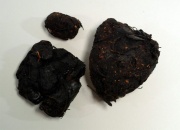Tamarind seed gum
Jump to navigation
Jump to search
Description
A polysaccharide derived from the seeds of the tamarind tree, Tamarindus indica, grown in India and southeast Asia but probably native to central Africa. Tamarind seeds contain about 65% Gum, 15-20% Protein, 6% Oil, and 3% ash. The carbohydrate portion contains Arabinose, Galactose, Xylose, galacturonic acid, and glucuronic acid. The gum dissolves in hot water to form a viscous solution that is high in Sugar. Tamarind gum is often used as a substitute for fruit Pectin and as an inexpensive textile sizing agent. It has also been used as a spray consolidant for flaking paint (Agrawal, 1984).
Synonyms and Related Terms
Tamarindus indica; goma de semillas de tamarindo (Esp.); gomma di semi di tamarindo (It); Indian date
Physical and Chemical Properties
Insoluble in cold water. Soluble in hot water.
| CAS | 39386-78-9 |
|---|
Resources and Citations
- O.P. Agrawal, Conservation of Manuscripts and Paintings of Southeast Asia, London: Butterworths,1984
- G.S.Brady, Materials Handbook, McGraw-Hill Book Co., New York, 1971 Comment: p. 381
- John S. Mills, Raymond White, The Organic Chemistry of Museum Objects, Butterworth Heineman, London, 2nd ed., 1994
- R. Newman, E. Farrell, 'House Paint Pigments', Paint in America , R. Moss ed., Preservation Press, New York City, 1994
- Book and Paper Group, Paper Conservation Catalog, AIC, 1984, 1989
- I.W. Cottrell, J.K. Baird, gums chapter
